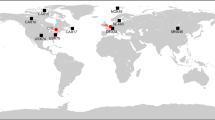Abstract
Radioxenon emissions of the TRIGA Mark II research reactor in Vienna were investigated with respect to a possible impact on the verification of the Comprehensive Nuclear Test-Ban-Treaty. Using the Swedish Automatic Unit for Noble Gas Acquisition (SAUNA II), five radioxenon isotopes 125Xe, 131mXe, 133mXe, 133Xe and 135Xe were detected, of which 125Xe is solely produced by neutron capture in stable atmospheric 124Xe and hence acts as an indicator for neutron activation processes. The other nuclides are produced in both fission and neutron capture reactions. The detected activity concentrations ranged from 0.0010 to 190 Bq/m³. The source of the radioxenon is not yet fully clarified, but it could be micro-cracks in the fuel cladding, fission of 235U contaminations on the outside of the fuel elements or neutron activation of atmospheric Xe. Neutron deficient 125Xe with its highly complex decay scheme was seen for the first time in a SAUNA system. In many experiments the activity ratios of the radioxenon nuclides carry the signature of nuclear explosions, if 131mXe is omitted. Only if 131mXe is included into the calculations of the isotopic activity ratios, the majority of the measurements revealed a “civil” signature (typical for a NPP). A significant contribution of the TRIGA Vienna to the global or European radioxenon inventory can be excluded. Due to the very low activities, the emissions are far below any concern for human health.


Similar content being viewed by others
References
Kalinowski MB, Pistner C (2006) J Environ Radioact 88:215–235
Saey PRJ (2009) J Environ Radioact 100:396–406
Saey P, Schlosser C, Achim P, Auer M, Axelsson A, Becker A, Blanchard X, Brachet G, Cella L, De Geer L-E, Kalinowski M, Le Petit G, Peterson J, Popov V, Popov Y, Ringbom A, Sartorius H, Taffary T, Zähringer M (2010) Pure Appl Geophys 167:499–515
Saey PRJ, Auer M, Becker A, Hoffmann E, Nikkinen M, Ringbom A, Tinker R, Schlosser C, Sonck M (2010) J Environ Radioact 101:730–738
Saey PRJ, Bowyer TW, Ringbom A (2010) Appl Radiat Isot 68:1846–1854
Bowyer TW, Biegalski SR, Cooper M, Eslinger PW, Haas D, Hayes JC, Miley HS, Strom DJ, Woods V (2011) J Environ Radioact 102:681–687
Kalinowski M, Axelsson A, Bean M, Blanchard X, Bowyer T, Brachet G, Hebel S, McIntyre J, Peters J, Pistner C, Raith M, Ringbom A, Saey P, Schlosser C, Stocki T, Taffary T, Ungar RK (2010) Pure Appl Geophys 167:517–539
Ringbom A, Larson T, Axelsson A, Elmgren K, Johansson C (2003) Nucl Instrum Methods Phys Res, Sect A 508:542–553
Steinhauser G, Villa M (2011) Appl Radiat Isot 69:1618–1620
ORNL (2000) SCALE: A Modular Code System for Performing Standardized Computer Analyses for Licensing Evaluation. In Nureg/Cr-0200, Rev 6 (ORNL/NUREG/CSD-2/R6), Vols I, II, and III
Steinhauser G, Sterba JH, Bichler M (2007) Appl Radiat Isot 65:488–503
Adlassnig W, Steinhauser G, Peroutka M, Musilek A, Sterba JH, Lichtscheidl IK, Bichler M (2009) Appl Radiat Isot 67:2117–2122
Haas DA, Biegalski SR, Foltz BKM (2009) J Radioanal Nucl Chem 282:677–680
Böck H, Hammer J, Schachner H, Klapfer E (1985) AIAU report 85301 Atominstitut
Acknowledgments
We thank Steven Biegalski (University of Texas) for interesting discussions as well as Irene Schraick (Austrian Institute of Technology) for providing gaseous xenon for our experiments.
Author information
Authors and Affiliations
Corresponding author
Rights and permissions
About this article
Cite this article
Steinhauser, G., Lechermann, M., Axelsson, A. et al. Research reactors as sources of atmospheric radioxenon. J Radioanal Nucl Chem 296, 169–174 (2013). https://doi.org/10.1007/s10967-012-1949-x
Received:
Published:
Issue Date:
DOI: https://doi.org/10.1007/s10967-012-1949-x




